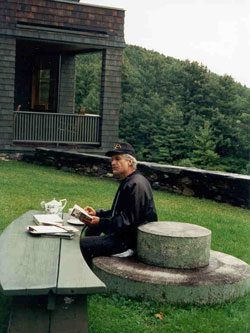 Kipling had a major influence on my writing and a lesser one on my life. The photo above is me in the garden of his house in Brattleboro in September, 1996. The one at the bottom of the essay is a more general shot of the house and grounds, looking down toward the Connecticut River. (The child is Sarah Van Name, the daughter of my friends Mark and Rana.)
Kipling had a major influence on my writing and a lesser one on my life. The photo above is me in the garden of his house in Brattleboro in September, 1996. The one at the bottom of the essay is a more general shot of the house and grounds, looking down toward the Connecticut River. (The child is Sarah Van Name, the daughter of my friends Mark and Rana.)
My folks had copies of The Jungle Book and The Second Jungle Book which I read them when I was quite young. The first volume contains the Mowgli stories, which are fairly straightforward. I won’t say that I understood them at age ten or so, but I thought I understood them.
The second volume has Rikki-Tikki-Tavi–mongoose kills cobras in aid of human beings, also straightforward; and others like The White Seal, stories of a form that I’d seen before in Thornton W. Burgess and elsewhere. And then there were the two that I didn’t begin to understand: The Undertakers, told by a group of carrion eaters; and Her Majesty’s Servants, a similar self-description but by the baggage animals of the army in India.
These last two stories are quite wonderful in the way they evoke the intertwining lives of beasts and men, but they were completely beyond me. The funny thing is, though, that I read them several times. I didn’t know what I was missing, but I did know there was something in the pieces.
Then I stopped reading Kipling for five years or so. The Jungle Books were the only volumes in our house, and it would never have occurred to me to go to the library to find more.
When I was fifteen I read Poul Anderson’s fine novel The Enemy Stars. Its magazine title was We Have Fed Our Sea from the Kipling poem of the same name, and it used snatches of the poem as epigraphs. That started me looking for the first time at Kipling’s verse, and I quickly became addicted to it. (Incidentally, Ripple Song is the end piece to The Undertakers; but if I didn’t understand the story you can bet I didn’t have a clue about that wonderful, horrifying poem.)
After I’d read all Kipling’s verse, I started reading the rest of the short stories as well. By this point in my life I was trying to write fiction and could appreciate not only the stories but the craftsmanship of the writer. This didn’t make me want to write even more: it depressed the dickens out of me because I knew I’d never be that good myself.
On the other hand, neither will anybody else. There are other fine English short story writers; H.G. Wells and Somerset Maugham are two of my favorites. At their best, they’re not as good as Kipling at his best; and Kipling was usually at his best, albeit he wrote stories of widely different styles.
For the first forty years of its existence, modern SF was a short story genre. As a result, it’s only to be expected that a short story writer as good as Kipling would be very influential in the field. My friend Sandra Miesel and I edited two anthologies of Kipling-inspired SF stories, but the effect he had on the field is far broader than that–and irrespective of the fact Kipling himself wrote quite a bit of SF.
I’ve learned a great deal from Kipling. About craftsmanship of course, but about people as well. He understood things he hadn’t personally experienced. In some cases they’re things that I have now experienced and he got it right, I swear he did. Any soldier who’s been sent overseas during wartime can find his soul laid bare in The ‘Birds of Prey’ March, and that one example can stand for hundreds.
I’ve got favorites of Kipling’s stories. The Devil and the Deep Sea shows how much men can accomplish when they devote themselves to a cause. The fact that these are bad men and their cause is scarcely good is beside the point–but at another level, that is the point.
The Janeites, summarized, is a comedy: a simple man is brought to love Jane Austen’s work and survives World War One as a result. Only, of course, he doesn’t survive, not really; and that’s something you might hear from other veterans, if you know them very well. The art which created a piece so affecting on all levels makes me shiver every time I read it.
So those are two I particularly like. If you’re a writer or want to be, you can learn from any story Kipling wrote; and if you care about human beings, there are things to learn on that score as well. He understood more than he can possibly have known.
For three years, 1893-6, Kipling lived in his wife’s home town of Brattleboro, Vermont. He built a house there to his specifications as a writer. I rented the house for the week of my 51st birthday and stayed there with family and friends. It’s a wonderful place to work–and I did–and also a wonderful place to reread Kipling.
But any place will do to read Kipling.

The child is Sarah Van Name, the daughter of my friends Mark and Rana.